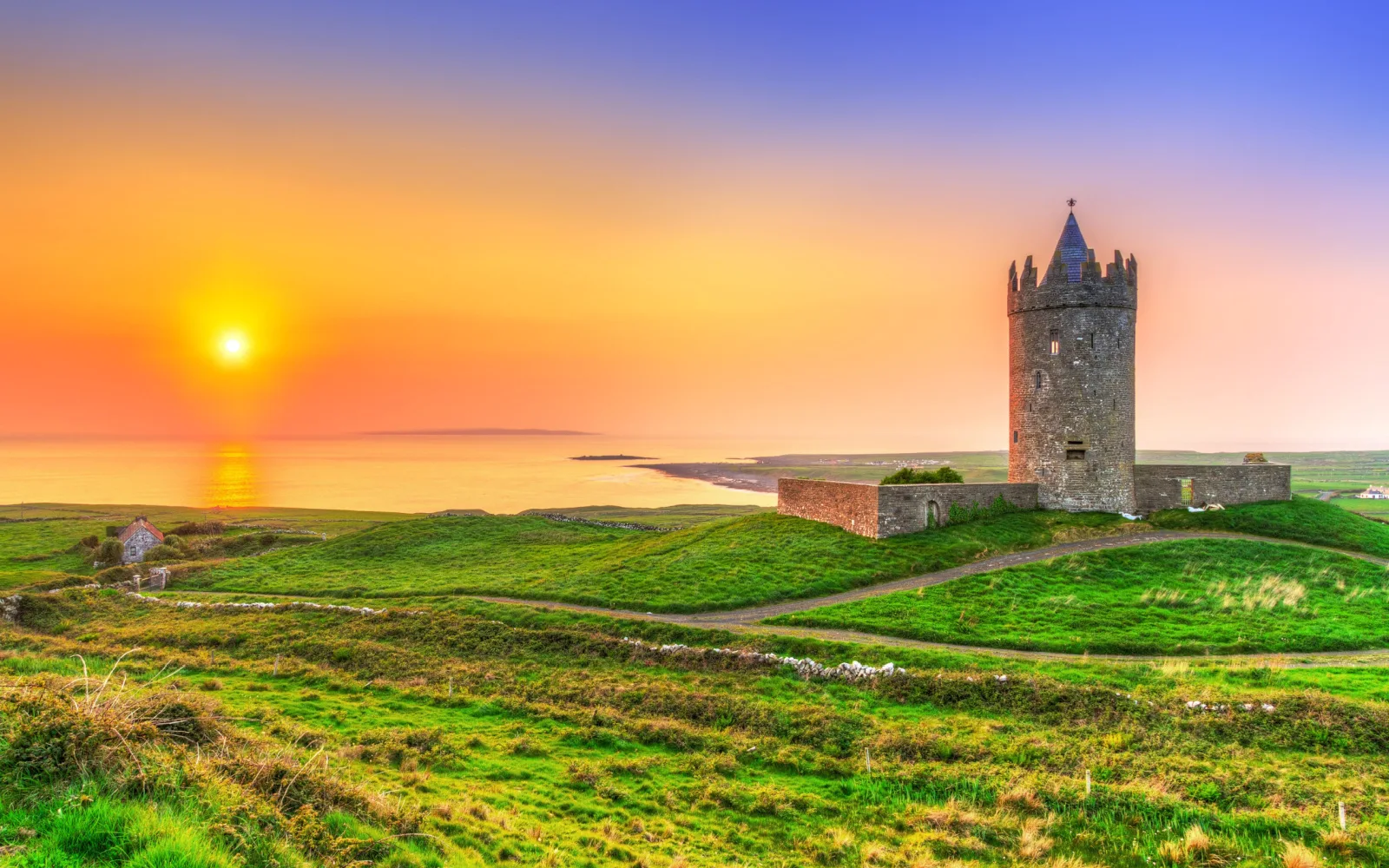What's an average trip to Ireland cost?
A trip to Ireland for one person typically will cost around $1,600. This estimate includes expenses for accommodation, round-trip flights, daily spending on food, drinks, and activities, as well as transportation.
On average, you can expect to spend about $80 per day on accommodation, with round-trip flights costing around $700. Daily expenses for food, drinks, and activities may average at $30 per person, while transportation costs can be approximately $25 per day.
If you were to take a random survey of people on the street, you’d be hard-pressed to find someone who doesn’t have Ireland occupying one of the top spots on their travel destination bucket list.
Who hasn’t dreamed of a trip to the Emerald Isle, land of shamrocks and leprechauns, rye whiskey and bannock cakes, ancient ruins, lush green landscapes, and maybe best of all, no snakes!
Luckily, a fun and educational Irish vacation is within the means of most people with a little planning and preparation. And the first place you should start is calculating a budget by determining how much your trip to Ireland is going to cost.
Obviously, your itinerary is a very personal thing and the cost of your trip to Ireland will depend on the things you want to see and do while you’re there.
And, of course, prices can go up or down somewhat between the time you plan your trip and the time you depart.
But by a careful consideration of all the variables involved in your travel and accommodations, you can arrive at a pretty good rough estimation of the total expense of your own trip.
And that’s just what our travel experts have done for you. We’ll show you the average prices for the basic trip necessities and offer you valuable pro-tips on how to save money, avoid hassles, stay safe, and have fun on your travels to this picturesque country.
Consider us your personal travel advisor for your upcoming trip to Ireland!
Average Trip to Ireland Cost in 2025
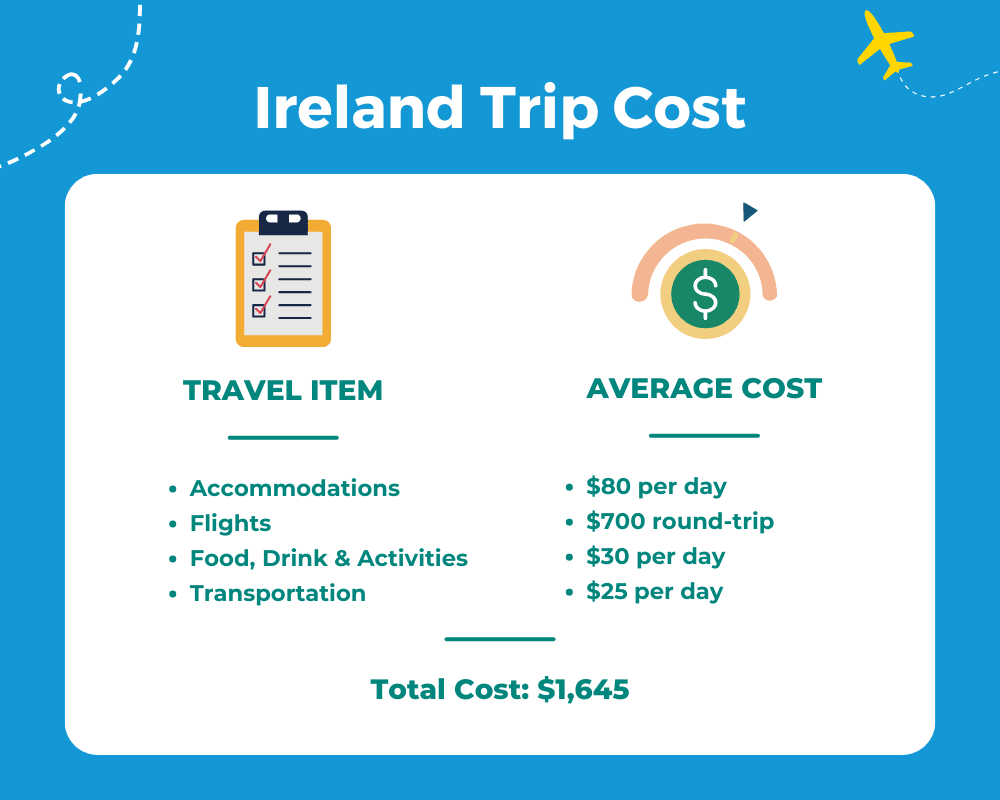
These are the current average cost estimates per person by category on a trip to Ireland:
- Average Accommodation Cost: $80 per day
- Average Flight Cost: $700 (round trip)
- Food, Drink, & Activities: $30 per day
- Transportation: $25 per day
- Total Cost: $1,645
Being such an attractive travel destination means that tourism is a big contributor to Ireland’s economy and they do all they can to make touring and sightseeing in the country as tourist-friendly as possible.
You’ll find a wide range of services and amenities, something to suit any budget and taste. No matter if you’re vacationing on a shoestring budget or splurging on your dream honeymoon, you’ll be able to plan the perfect itinerary for your trip to Ireland.
Let’s take a closer look at each of these expense categories below along with some helpful insights and tips.
Ireland Trip Cost: Average by Item
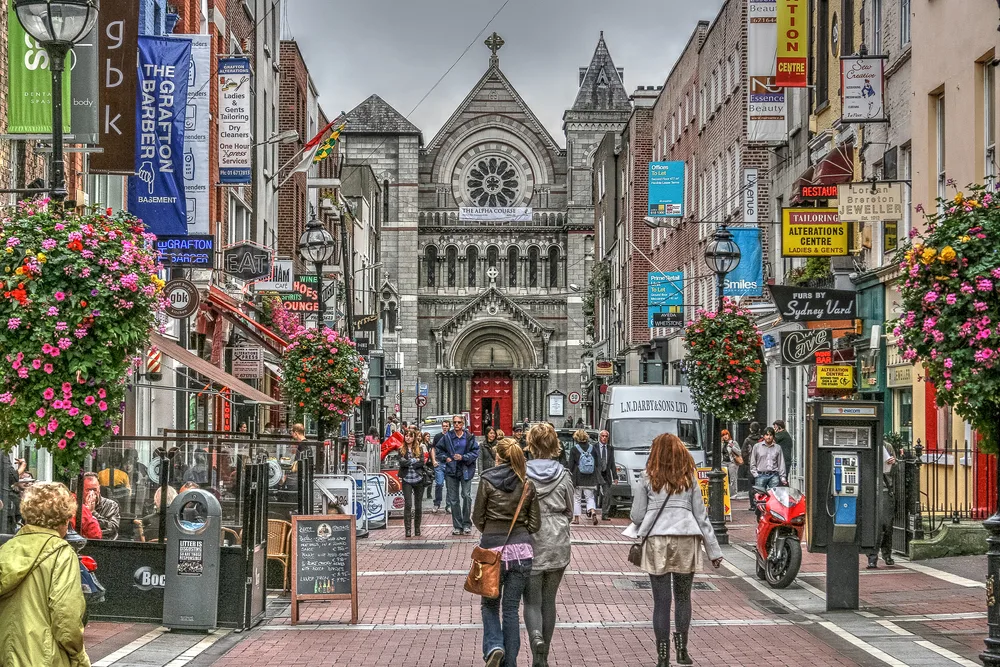
Jamegaw/Shutterstock
Accommodation Costs
Ireland boasts a wide variety of options for the weary traveler to rest their head after a long day of exploration and adventure. You’ll find all the usual hotels, B&Bs, Airbnb rentals, inns, and guesthouses, as well as a plethora of more exotic and unusual accommodations.
You’ll have no trouble finding a place to stay regardless if your destinations are rural or urban. Standards of cleanliness and safety in public accommodations are high all around the country.
For the really budget-conscious tourist, it’s possible to find youth hostels and church or charity traveler shelters for cheap or free. Hotels tend to run between $15 and $20 per night.
To really experience the history, heritage, and natural beauty of the island, consider renting a room in one of the many ancient castles or in a quaint thatched-roof cottage.
You can spend some time in a centuries-old house on a working farm or on the ocean in a small fishing village.
Hotels in Ireland are rated with the familiar 5-star system, and the more luxurious, and expensive, establishments are located in the larger cities such as Dublin, Galway, and Cork.
As with any travel destination, prices are lower in the off-season and higher in the peak season from spring to late fall.
Flight Costs
Commercial flights to Ireland will vary widely according to your departure point, but the worldwide average runs from as low as $350 to $1,600 per person for economy class and from $1,700 to $5,000 for a first-class seat.
Pretty much every major airline offers flights to Eire though, as always, you should shop around for the best deals and easiest routes. Ireland boasts five busy international airports, with the largest being Dublin Airport, followed by the airports in Shannon, Knock, Belfast, and Cork.
The cheapest flights to Ireland will be found in the off-season from around September to April, except for the holiday season from mid-December to mid-January, and, of course, around St. Patrick’s Day in March.
It’s generally good practice to book your travel well in advance and to be flexible in your travel dates to find the best deals.
You don’t want to have any nasty surprises pop up on your trip to Ireland, so always check with the official Irish government website for any travel restrictions or advisories before you leave.
Food, Drink, & Activity Costs
An indispensable part of the fun of traveling to a new place is sampling the local culinary fare and entertainment venues.
It simply wouldn’t be a proper trip to Ireland if you didn’t try the traditional foods, quaff the locally brewed stouts and liquors while enjoying the unique Irish pub culture, and see and do all the cool stuff you’ll discover on your route.
But remember food, drink, and entertainment costs can quickly add up and bust your budget. The reported average is about $30 per day per person, but with so much temptation around, you should probably pad that figure by at least another $20.
You’ll find all the familiar fast-food restaurants in Ireland in the cities and smaller towns, as well as smaller family-style restaurants catering to the locals with reasonable prices.
You should be able to save enough on most days to afford a more lavish dinner or two in the city or on the coast. Don’t ignore the many pubs you’ll encounter for excellent food at prices that won’t strain your wallet.
Tipping isn’t as big of a thing in Ireland as it is in the U.S. and you’ll often find a small service fee added to your bill in lieu of leaving a tip. If you do want to leave a tip, the usual 10-15 percent is fine or even just rounding up the tab will suffice.
You’ll come across lots of farmer’s markets in the Irish countryside with low-priced locally grown and raised products and it’s quick and easy to stop and gather the ingredients for a lovely and economical picnic in a roadside park or historical site.
Fish markets abound on the coasts too. If you plan your itinerary so you can stay at inns and hotels that offer a kitchenette, you can even cook your own cheap meals on the road.
Transportation Costs
Ireland is blessed with a great public transportation system and it’s entirely doable to go anywhere you want by train and bus and in taxis and ride shares in the cities.
The fares are quite reasonable, their infrastructure is modern and well-maintained, and the carriages are clean. Depending on your mode of transport, $25-$50 per day per person is a good estimate for transportation costs.
You can also book tours that will shuttle you around to all the main tourist destinations and, although that might be more expensive, it may be worth it to save time and trouble.
But to really experience the Irish countryside, you can’t beat driving yourself in a rental car. If you’re only going to be in the country for a short time, your regular driver’s license will suffice.
Yes, they drive on the wrong side of the road in Ireland, but you’ll find that with a little bit of careful practice on the side roads you’ll have it mastered in no time.
Rental rates are about the same as in the U.S. but insurance fees can be higher because of damage routinely caused by tourists driving down narrow roads.
Also, most rental cars will sport a manual transmission, so if you need an automatic, you should let the rental car company know in advance and be ready to pay a higher fee.
Things to Consider
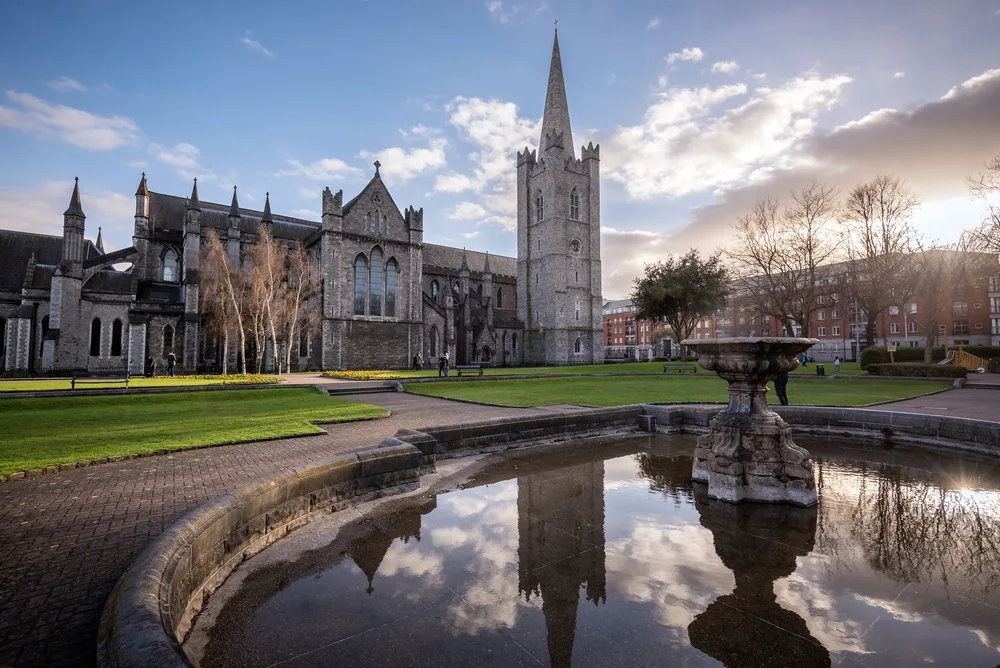
SAKhanPhotography/Shutterstock
Here are a few other things besides costs to keep in mind to ensure that your trip to Ireland is fun and hassle-free:
- Your phone’s maps app won’t always be accurate on the back roads of rural Ireland, so make sure you have an old school paper map with you as a backup. Many of the roads you’ll encounter off the beaten path will be narrow and curvy and your travel will be slow, so make the necessary time adjustments to get to your destination.
- You’ll need to bring a plug adaptor, as Ireland uses 230v/50hz, requiring a three-prong adapter. In some places, you may need a voltage converter unless your device is rated for dual voltage. Check it out before plugging things in.
- There’s a difference between the Republic of Ireland and Northern Ireland. The much smaller region in the north of the island is still a part of the UK, so if you want to go there you’ll be crossing a border into a different country.
- The Euro is used in the Republic of Ireland, while in the north they use the British Pound. If you’re going to carry cash and are going over the border or near it you might want to have some of both on hand. However, ATM machines and currency exchanges are plentiful and credit cards are widely accepted pretty much everywhere, so you shouldn’t have any trouble paying for things.
- English and Gaelic are both official languages in Ireland and the road signs are usually written in both. But don’t worry, although you might encounter people speaking Gaelic in the smaller villages, you’ll get by just fine in English, although you might have some difficulty understanding the heavy brogue accent.
Frequently Asked Questions
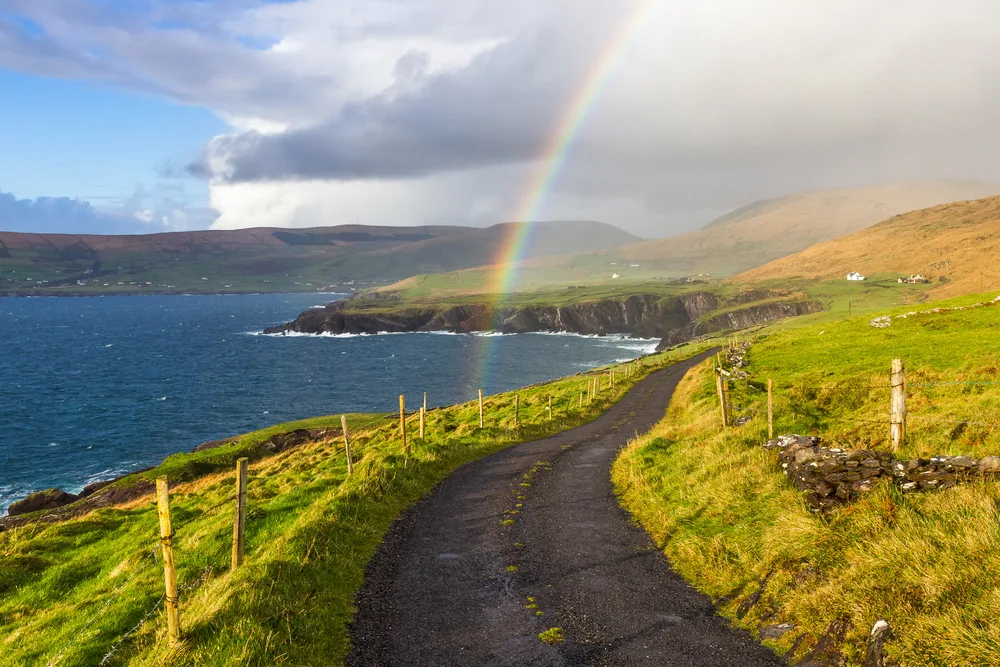
Jan Stria/Shutterstock
Will I need a visa to visit Ireland?
It depends on which country you’re coming from. If you’re a citizen of the EU or the EAA member states (Norway, Iceland, and Lichtenstein), the U.S., Canada, Great Britain, Australia, or New Zealand, then you don’t need a visa to enter Ireland.
What is the best time of year to take a trip to Ireland?
The summer months from June to August offer wonderful weather and longer days, although spring and fall can also be mild and pleasant and have the advantage of attracting fewer tourists and thus having fewer crowds and better travel deals.
What kind of clothes should I pack for the Irish weather?
The Irish weather is famous for being unpredictable and capable of changing very quickly. One day it can be sunny and warm and the next it might be chilly and raining. Even in the summer, the evenings can be chilly. Be sure to bring along some warm clothing and a waterproof jacket along with some comfortable shoes for walking.
What are some must-see attractions in Ireland?
The most visited attractions include the famous Cliffs of Moher, the Giant’s Causeway, the Ring of Kerry, Trinity College, and the Guinness Storehouse, just to name a few. The city of Dublin is considered a must-visit by many tourists. You’ll never get bored in Ireland.
Is it safe to travel in Ireland?
Ireland is considered by most to be a very safe tourist destination. You’ll need to exercise the same common sense you would use back home. Take precautions against pickpockets and petty thieves in the cities and in crowds.
So, What Does an Average Trip to Ireland Cost?
| 🛎️ Average Accommodation Cost | $80 per day |
| ✈️ Average Flight Cost | $700 (round trip) |
| 🍽️ Food, Drink & Activities | $30 per day |
| 🚕 Transportation | $25 per day |
| 💲 Total Cost | $1,645 |
Our estimate of an average cost of $135 per person per day for a trip to Ireland, based on recent tourist surveys and reports, is pretty accurate for someone trying to stay within a budget yet splurging occasionally on experiences.
But in the end, the cost of your trip to Ireland is completely up to you and what you want to do and see in this beautiful, ancient, and magical country.
So, with so much to see and do and the ability to visit this amazing country on a budget, what are you waiting for — book your trip today and experience for yourself all that Ireland has to offer. Happy travels!



